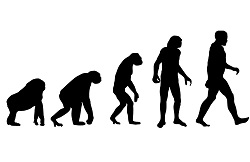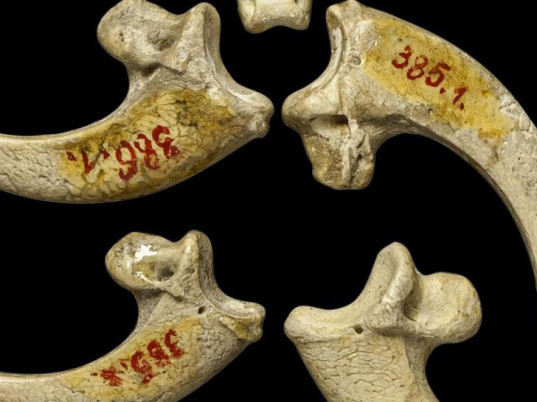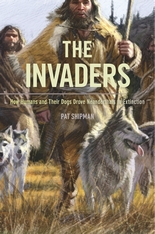 Everyone knows we came out of Africa. Yet at one stage, many millions of years ago, our ancestors disappeared from Africa, but remained in Europe. Then Europe emptied out back into Africa. Some of the key traits that make us human such as big brains, dexterous hands, erect posture and a long childhood developed in Europe and were then taken back to Africa. Continue reading Our deep origins in Europe and Africa
Everyone knows we came out of Africa. Yet at one stage, many millions of years ago, our ancestors disappeared from Africa, but remained in Europe. Then Europe emptied out back into Africa. Some of the key traits that make us human such as big brains, dexterous hands, erect posture and a long childhood developed in Europe and were then taken back to Africa. Continue reading Our deep origins in Europe and Africa
Tag Archives: Neanderthals
Saturday salon 9/1
1. Neanderthal DNA lives on
About 1.5 to 2.1 percent of the DNA of anyone outside Africa is Neanderthal in origin. But the DNA is not evenly spread. Your Neanderthal DNA may be different from mine. Scientists have found at least 20% of the Neanderthal DNA in humans. That’s what they’ve found, the toatal may be twice as much. Continue reading Saturday salon 9/1
Saturday salon 18/4

An open thread where, at your leisure, you can discuss anything you like, well, within reason and the Comments Policy. Include here news and views, plus any notable personal experiences from the week and the weekend.
For climate topics please use the most recent Climate clippings.
The gentleman in the image is Voltaire, who for a time graced the court of Frederick II of Prussia, known as Frederick the Great. King Fred loved to talk about the universe and everything at the end of a day’s work. He also used the salons of Berlin to get feedback in the development of public policy.
Fred would only talk in French; he regarded German as barbaric. Here we’ll use English.
The thread will be a stoush-free zone. The Comments Policy says:
The aim [of this site] is to provide a venue for people to contribute and to engage in a civil and respectful manner.
Here are a few bits and pieces that came to my attention last week.
1. Hilary Clinton runs for president
As expected Hilary Clinton has thrown her hat into the ring to become the Democrat candidate for the US presidency. So far it looks like her against the Republicans, perhaps about 20 of them. Mashable Australia takes a look at alternative Democrat candidates.
It seems that Senator Elizabeth Warren is the only one that would cause real fear to the Clinton campaign, and she has said about 4,398 times she’s not running.
2. Neanderthals made jewellery 130,000 years ago

A team of American and Croatian scientists have uncovered evidence that European Neanderthals were manipulating raptor talons to make jewelry at least 130,000 years ago, or about 80,000 years before the first Homo sapiens even stepped foot on the continent.
In the popular mind Neanderthals are thought of as bumbling simpletons, but we should remember that their brains were bigger than ours.
The article also points out that catching three of four eagles to make the jewellery was no mean feat.
3. CEO radically redistributes staff pay after reading wellbeing research
Dan Price, CEO of Gravity Payments in Seattle, decided to pay everyone $US70,000 after reading wellbeing research. He did this by reducing his own salary from $1 million to $70,000 and redistributing some of the company’s profits. He gave two reasons.
Firstly the research shows that increased wellbeing tapers rapidly after reaching $75,000. Secondly, happy staff are more productive.
A very rational decision!
4. Not so good news
There’s been plenty to be sad and sorry about on the intertubes lately. The stories of bestial treatment coming out of the Neerkol Orphanage in Rockhampton are beyond belief. It wasn’t just the priests and nuns who did the abusing. A Queensland Government official covered up the abuse. The former bishop allowed a priest to stay on at a parish even though he knew he was a paedophile, gave the priest a character reference and described reports of abuse at Neerkol as “scurrilous”.
On the box we were told that 31 women had died from domestic violence so far this year, shaping as worse than the 84 deaths recorded last year.
COAG laboured and came up with some measures which don’t cost money. It’s all well and good but probably won’t make much difference.
The biggest killer apart from probably tobacco has been suicide:
The National Mental Health Commission’s findings show more people die by their own hand than are killed in road accidents or by skin cancer. And it notes while Australia’s road toll has more than halved in 40 years, there has been little change in the suicide rate, which was double the road toll in 2012.
Health Minister Sussan Ley has sent the Commission’s report off to a reference group. She has “confirmed she won’t accept a key recommendation to channel $1 billion of hospital funding to community health programs instead.”
Truth be known we probably need additional funding to crank up community programs while then winding down hospital funding as the need diminishes.
5. Centre for Policy Development loses some sheen
The Centre for Policy Development is supposed to be a left wing think tank. Now it has supported a broadening of the GST base including a GST on fresh food. Mark Bahnisch, Eva Cox and John Quiggin have resigned as Fellows as a result. Here’s Quiggin’s statement.
Good on them!
How humans and their dogs drove Neanderthals to extinction
Well strictly speaking Neanderthals are humans too, so for “humans” read Homo Sapiens, that is us.

I intended to write a post on taxation policy, but then I heard Phillip Adams’ segment Dogs: not the Neanderthals best friend, an interview with retired anthropologist Pat Shipman on her hypothesis that the domestication wolf-dogs gave us the critical edge to out-compete the Neanderthals. It reminded me of an article by Shipman in the New Scientist. If that’s paywalled there is an excellent exposition of her ideas by Steve Donoghue at Open Letters Monthly.
Anyway Sapiens vs Neanderthalensis won out over tax policy.
Shipman uses the example of Yellowstone National Park to demonstrate the effect a top predator can have on a whole ecosystem.
Though wolves were integral to that ecosystem for millennia, they were wiped out there by settlers by about 1920. The effects of removing the wolf were striking. Coyotes formed larger, more wolf-like packs, while elk populations soared, changing the vegetation close to rivers by eating young trees and shrubs. Pronghorn antelope populations dropped as more coyotes preyed on their offspring; beavers disappeared from the park and songbirds declined in number.
Then:
Reintroducing just 31 wolves in the mid-1950s transformed the ecosystem again. Wolves targeted their closest competitor, killing coyotes in confrontations over carcasses and consuming enough prey to hinder their survival. Coyotes avoided areas favoured by wolves and shifted to smaller prey. Coyote packs fragmented and their overall population declined sharply. More pronghorns survived; elk herds diminished; and riverine vegetation came back, encouraging the return of beavers and songbirds.
Neanderthals survived for about 250,000 years in an environment that presented challenges. Donoghue describes it thus:
Their populations had endured sweeping climate changes over the centuries, and they shared their landscape with animals as monstrous as anything the world had seen since the dinosaurs: massive cave bears, saber-toothed tigers, lions bigger than any in Africa today, cave hyenas, huge woolly mammoths, woolly rhinoceri, wolves, leopards, roving packs of dholes – a world as fearsome and strange as something out of a science fiction novel.
A few thousand years after Sapiens arrived some 45,000 years ago, apart from wolves all these large animals were gone, and the Neanderthals with them.
Shipman says that the common belief was that the Neanderthals moved south to avoid the advancing ice, and lingered until 27,000 years ago. However, she says that modern dating technology shows no southward movement and no trace of Neanderthals after 39,000 years ago.
Sapiens had two big advantages. One was projectile technology to enable killing at a distance. The other was possibly the assistance of the domesticated wolf-dog. Dogs assisted Sapiens in hunting and acted as guards.
It seems likely that Sapiens did not tolerate the presence of Neanderthals in ‘their’ territory. It seems likely also that with projectile weapons Sapiens would win any direct confrontation. If the Neanderthals crept up at night, the dogs would likely smell them and sound the alarm.
The effect of dogs was to increase the ecological niche in which Sapiens could operate. For the Neanderthals there was simply no good place to go, so they were squeezed into areas where they could not support themselves in the longer term. In this, climate change was still certainly a factor.
Shipman says we are “natural invaders, the mammalian equivalent of Burmese pythons, cane toads and Asian carp.”
Shipman stresses that her hypothesis “still requires elaboration and testing.” Nevertheless it is certainly food for thought.
Shipman’s book on the topic is The Invaders: How Humans and Their Dogs Drove Neanderthals to Extinction.
You might also be interested in Neanderthals r us and Sex with Neanderthals was good for us from 2011. Seems like yesterday.

